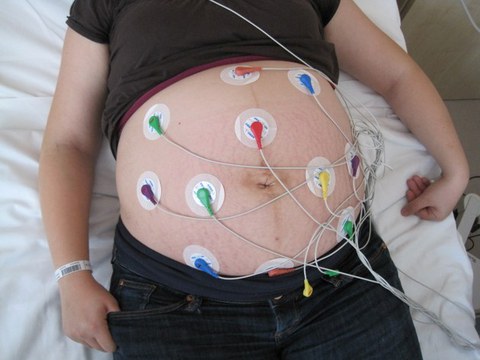Fetales Monitoring – Innovation für die pränatale Diagnostik [fEKG]

Platzierung abdominaler Elektroden zur Erfassung des fetalen EKG
Die Möglichkeiten der fetalen Diagnostik sind heute äußerst begrenzt. Insbesondere mangelt es an Verfahren, die nicht-invasiv und einfach anwendbar, ggf. auch außerklinisch und über längere Zeiträume, den fetalen Gesundheitszustand erfassen können.

Gerätetechnik zur Erfassung des fetalen EKG
Das fetale Elektrokardiogramm (fEKG) mittels abdominaler Elektroden bietet eine derartige Möglichkeit. Dabei werden die elektrischen Signale vom Bauch der Mutter erfasst. Das Ergebnis ist eine Mischung aus fetalem EKG, mütterlichem EKG und Rauschen. Die korrekte Extraktion des fEKG ist bis heute problematisch.
Die Arbeitsgruppe Biosignalverarbeitung befasst sich mit innovativen Algorithmen zur Extraktion des fEKG. Daneben werden die Inhalte des fEKG detailliert untersucht, um fEKG-basierte Marker der fetalen Entwicklung zu identifizieren. Außerdem werden neuartige Monitoringverfahren und -systeme für den klinischen und außerklinischen Bereich angestrebt. So soll mit einfacher Hardware, z.B. integriert in Smartphones, zukünftig eine Abschätzung des fetalen Risikos möglich werden.
Weiterführende Informationen auf der Website der AG Biosignalverarbeitung.

Abdominale Signalaufnahme
WEITERFÜHRENDE LITERATUR
- F. Andreotti, M. Riedl, T. Himmelsbach, D. Wedekind, N. Wessel, H. Stepan, C. Schmieder, A. Jank, H. Malberg, and S. Zaunseder, “Robust fetal ECG extraction and detection from abdominal leads.,” Physiol. Meas., vol. 35, no. 8, pp. 1551–1567, Jul. 2014.
- F. Andreotti, J. Behar, S. Zaunseder, J. Oster, and G. D. Clifford, “An open-source framework for stress-testing non-invasive foetal ECG extraction algorithms.,” Physiol. Meas., vol. 37, no. 5, pp. 627–648, Apr. 2016.
